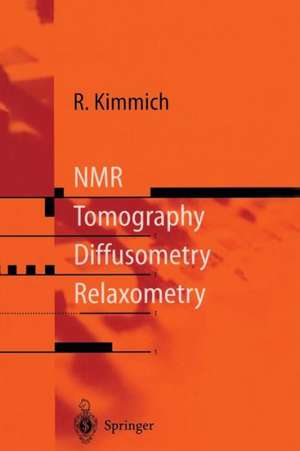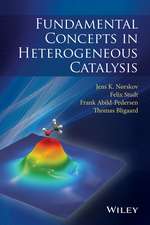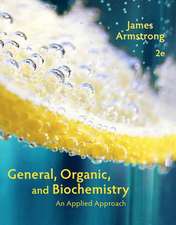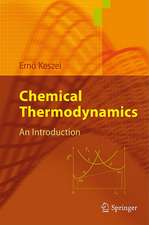NMR: Tomography, Diffusometry, Relaxometry
Autor Rainer Kimmichen Limba Engleză Paperback – 28 oct 2011
Preț: 403.15 lei
Nou
Puncte Express: 605
Preț estimativ în valută:
77.15€ • 80.09$ • 64.33£
77.15€ • 80.09$ • 64.33£
Carte tipărită la comandă
Livrare economică 22 martie-05 aprilie
Preluare comenzi: 021 569.72.76
Specificații
ISBN-13: 9783642644658
ISBN-10: 3642644651
Pagini: 556
Ilustrații: XXIII, 526 p.
Dimensiuni: 155 x 235 x 35 mm
Greutate: 0.77 kg
Ediția:Softcover reprint of the original 1st ed. 1997
Editura: Springer Berlin, Heidelberg
Colecția Springer
Locul publicării:Berlin, Heidelberg, Germany
ISBN-10: 3642644651
Pagini: 556
Ilustrații: XXIII, 526 p.
Dimensiuni: 155 x 235 x 35 mm
Greutate: 0.77 kg
Ediția:Softcover reprint of the original 1st ed. 1997
Editura: Springer Berlin, Heidelberg
Colecția Springer
Locul publicării:Berlin, Heidelberg, Germany
Public țintă
ResearchCuprins
I: Spin Coherences and Echoes.- 1 Introductory Remarks.- 2 Isolated Spins in Inhomogeneous Fields.- 3 Rotary Echoes.- 4 Solid Echoes of Dipolar-Coupled Spins.- 5 Solid Echoes of I =1 Quadrupole Nuclei.- 6 Dipolar and Quadrupolar Magic Echoes.- 7 Coherence Transfer of J-Coupled Spins.- II: Molecular Motion.- 8 Survey.- 9 Categorization of Relaxation Phenomena.- 10 Spin-Relaxation Functions.- 11 Perturbation Theory of Spin Relaxation.- 12 Spin-Lattice Relaxation.- 13 Transverse Relaxation.- 14 Examples of Autocorrelation Functions.- 15 Field-Cycling NMR Relaxometry.- 16 Field-Cycling Relaxometry in Biosystems.- 17 The Dipolar-Correlation Effect.- 18 Survey of NMR Diffusometry.- 19 Main-Field Gradient NMR Diffusometry.- 20 Reciprocal- vs Real-Space Representations.- 21 RF-Field-Gradient NMR Diffusometry.- 22 Examples for Anomalous Self-Diffusion.- 23 Exchange.- III: Localization and Imaging.- 24 Survey.- 25 Fundamentals of NMR Imaging.- 26 Parameter-Weighted Contrasts.- 27 Relaxation-Dispersion Maps.- 28 Frequency-Offset Maps.- 29 Gradient-Pulse Moments and Motions.- 30 Velocimetry and Velocity Maps.- 31 Diffusivity Maps.- 32 Resolution.- 33 Multi-Stripe/Plane Tagging.- 34 Rotating-Frame Imaging.- 35 Imaging of Solid Samples.- 36 Slice-Selective Homonuclear Spin-Locking.- 37 Homonuclear Localized NMR.- 38 Cross-Polarization Principles.- 39 Single-Transition Operator Theory of Cross-Polarization.- 40 Proton-Detected Localized 13C NMR.- 41 Heteronuclear Imaging.- IV: Analytical NMR Toolbox.- 42 Miscellaneous Formulae and Rules.- 43 Rules for Traces.- 44 Commutator Algebra.- 45 Exponential and Trigonometric Operators.- 46 Spin Hamiltonians.- 47 The Density Operator.- 48 Unitary Transformations in NMR.- 49 Irreducible Spherical Tensor Operators.- 50 Derivation of Basic NMR Spectra.- 51 Product Operators for Spins.- 52 Spin Operators for I = 1 Quadrupole Nuclei.- References.
Textul de pe ultima copertă
Tomography, diffusometry and relaxometry are fields based on common physical principles. The combined use of such techniques provides synergistic insight into physicochemical material properties of an object. The difficulty which newcomers to the field face is to practice and to apply theoretical formalisms from different sources while still learning the principles of NMR and while being already engaged in NMR research. So the author's ambition is a treatise that offers easy and quick access for the reader to any implied matter of interest. He has exerted himself to facilitate the comprehension of NMR principles by extensive cross-referencing among the sections and chapters.








